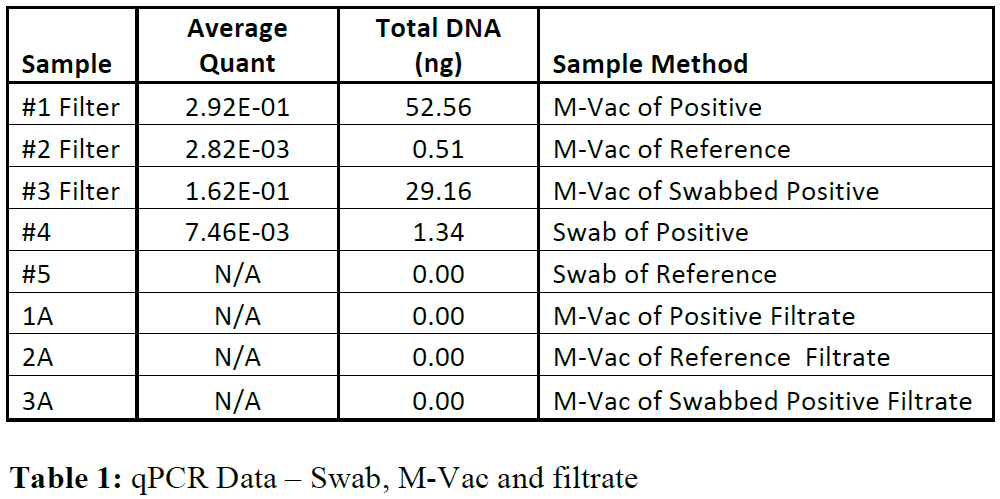
Filter Verification Testing
Objective: Verify the use of a 0.45 µm polyethersulfone (PES) filter and disposable sterile filtering apparatus as a sample concentration means for M-Vac™ samples via the sampling of mock DNA evidence and the use of traditional DNA processing methods. Utilize the double swab method as a reference in the experiment.
Methods: Four swatches of black cotton were used. Two were stained with 2 mL of 10:1 diluted saliva and allowed to dry. Two were left blank as a reference. Two swatches, one stained and one reference, were sampled using the double swab method. The remaining two swatches, one stained and one reference, were sampled using the M-Vac™ system. The swatch that had been stained and sampled with the double swab method was resampled using the M-Vac™ system. The swabs were allowed to dry and the M-Vac™ collections were concentrated using Nalgene Rapid Flow Sterile Disposable Filter Units with 0.45 micrometer PES filter and allowed to dry. The filtrate from the concentrations was also retained and sent with the other collections to the lab for analysis. As a technical note, the filter apparatus is compatible and operates with the M-Vac™ System’s vacuum supply equipment.
Extraction/Analysis: The swabs were removed and placed into extraction tubes. The filters were removed and cut into small pieces and placed into extraction tubes. The bottles of filtrate were concentrated/pelleted in a centrifuge using 50 mL Falcon tubes. The swabs, filters and pellets were processed using a Chelex extraction and quantitated with a Plexor HY System.
Results: The M-Vac™ collected 39 times more DNA than the swab and 22 times more when collecting from a swatch that had already been double swabbed (see table). The filter collected the epithelial cells in the M-Vac™ collections and the filtrate quantifications had zero nanograms of DNA.

Conclusions: A 0.45 micrometer PES filter is a viable concentration method for DNA material suspended in buffer. The filter retained the epithelial cells from the M-Vac™ collections. The filter material did not inhibit the DNA extraction or qPCR processes. The M-Vac™ wet-vacuum method collected significantly more DNA material from the black cotton than did the double swab method.
Acknowledgements: This research was conducted by West Jordan PD and Sorenson Forensics under the direction of M-Vac™ Systems. A full report is available upon request.